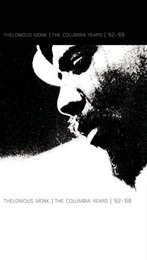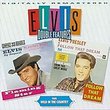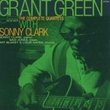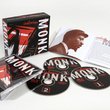| All Artists: Thelonious Monk Title: Columbia Years 1962-1968 (Spkg) Members Wishing: 1 Total Copies: 0 Label: Sony Release Date: 9/14/2004 Album Type: Box set, Original recording remastered Genres: Jazz, Pop Styles: Modern Postbebop, Bebop Number of Discs: 3 SwapaCD Credits: 3 UPC: 827969268322 |
Search - Thelonious Monk :: Columbia Years 1962-1968 (Spkg)
 | Thelonious Monk Columbia Years 1962-1968 (Spkg) Genres: Jazz, Pop
|
Larger Image |
CD DetailsSimilar CDs
|
CD ReviewsA reasonable overview of Monk's later work. Michael Stack | North Chelmsford, MA USA | 01/31/2006 (3 out of 5 stars) "Somewhat less relevent now then it was upon its original release, "The Columbia Years" is a three disc overview of Thelonious Monk's six year tenure with Columbia Records in the 1960s. The material was all being worked up for remastering/reissuing and this set was distributed as an overview of sorts. Perhaps the most important thing the set did was provide an opportunity for the notion of reevaluating Monk's time on Columbia, often maligned by fans and critics, but with the majority of this material having been reissued in the time since this set, the necessity of this set is minimized, but for what it is, it's a fine compilation. In 1962, Monk was on top of the world-- after brief recording stints with Blue Note and Prestige and a lengthier one with Riverside, he was signed to a major label and he had a working quartet featuring tenor saxophonist Charlie Rouse. The quartet format dominates this material-- in fact seven of the nine studio albums Monk did featured his quartet. This is one of the facets that dominates the negative feelings towards Monk's material-- his '50s work featured more varied bands, but this was Monk's first band he'd held together for a while, and as Peter Keepnews points out in the liner notes, no one criticized Miles Davis for several years of recording with a quintet or John Coltrane for the same crime with his quartet. So why Monk? It could be the other facet of discussion concerning the Columbia material-- Monk's increasing reliance on older compositions-- with the exception of the superb "Underground", the albums by and large featured older compositions (although again Keepnews is clear to point out that the Riverside sessions were dominated by material recorded for Blue Note). What is certain is that it's a fine opportunity to hear a number of classic Monk compositions well honed and performed by a quartet who fully understood his music. The thing about Monk's Columbia recordings is that while they may have surrendered variety a bit, they were consistently of remarkably high quality-- the albums tend to stick out a bit less than the early material, but none of them are disappointing listens. And by the way, as far as the material being recorded-- it's not like "Stuffy Turkey" received dozens of readings over the years (although it was left off here-- the compiler stated one of the goals was to cover the essential Monk compositions in one form or another). The set divides in half between studio and live material, with both about half quartet recordings. The previously unreleased material as previously unreleased as it was when this came out-- the reissues of Monk's Columbia catalog saw to that, although this is the best sonic quality available of any of the material from the as-yet-not-24-bit-remastered "Monk's Blues" (perhaps the most unloved of Monk's albums). And certainly you get quite a bit, from fantastic quartet live readings ("Jackie-ing") to bouncy solo piano ("Dinah") and as far as I know the only vocal number in Monk's catalog ("In Walked Bud" with Jon Hendricks). I'd argue about the track selection, but any fan of Monk likely would-- it is what it is, a reasonable three CD overview of Monk's career. This set is a reissue of an older set in more conventional packaging-- this is probably a good thing, although I had no problems with the old package, a lot of folks found CDs slipped out of the holders. Admittedly, I haven't exacty talked a lot about the music on here-- that's because truthfully, the set is pretty extraneous with the most recent array of Monk remasters having released the unreleased material, and truthfully as an overview or introduction to Monk, there's better examples-- "Genius of Modern Music Volume 1" on Blue Note is probably the best introduction to his compositions (collecting old singles from the '40s), "Live at the 'It' Club" on Columbia is the best introduction to his great quartet with Rouse and his later work, and the recently found "At Carnegie Hall" is probably the best way to approach Monk in general. Most people who will invest in a three disc set don't need convincing. This one sounds nice, but the material's all available elsewhere (barring the aformentioned two cuts from "Monk's Blues" in stunning remastered quality), newcomers should seek elsewhere, diehards can evaluate whether they really need this." Making a Profit on the Prophet R. Theis | New York, City | 06/14/2008 (2 out of 5 stars) "Monk's idiosyncratic style is a jewel in the crown of jazz. This three-CD box, meant to be a survey of his best work for Columbia, holds some interest, but his finest work was recorded earlier for Blue Note, Prestige, and Riverside. In fact, the lion's share of the titles on "The Columbia Years" had already been recorded for one of the above mentioned labels.
Further, "The Columbia Years" includes lots of unissued takes and restored versions of previously edited takes. This would be fine for a Monk "rarities" album, but not for a purported "best of" collection. The only reason for their inclusion in place of the takes previously deemed superior is to encourage sales of the box to those Monk "completests" who have most of the original versions of songs on "The Columbia Years" already. Thus, those of us who want the best of the Columbia years have to settle for obscurities to attract more sales in place of important, quality recordings for Columbia that were left off in their stead. Finally, the packaging, though innovative and nice looking, is not user friendly and does not securely hold or protect the discs. All in all this compilation is a bust. For a better survey of his genius, I would recommend these far superior single-disc collections: "The Best of Thelonious Monk: The Blue Note Years" (Blue Note), "Thelonious Monk" (Prestige), and "Thelonious Monk and the Jazz Giants" (Riverside). These three individual discs contain about two-thirds of the songs on the three discs comprising "The Columbia Years" and many Monk classics not recorded for Columbia or not in this album. And these single-disc "best ofs" provide a large variety of supporting players, who happen to be a "who's who" of jazz legends as well: John Coltrane, Coleman Hawkins, Sonny Rollins, Gerry Mulligan, Harold Land, Thad Jones, Johnny Griffin, Phil Woods, Philly Jo Jones, Clark Terry, Donald Byrd, Art Blakey, Max Roach, Milt Jackson, Kenny Dorham, Lou Donaldson, Paul Chambers, etc.--UNLIKE "The Columbia Years" box set with its very limited supporting cast." |

 Track Listings (11) - Disc #1
Track Listings (11) - Disc #1

